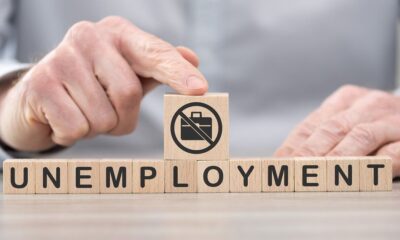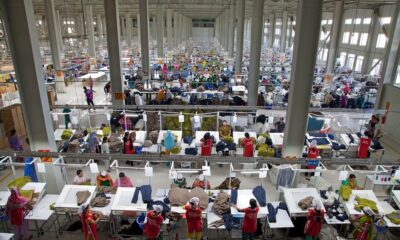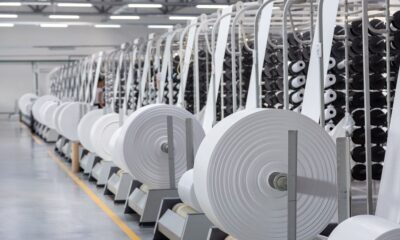Fashion
S&P sees China growth slowing to 4% in H2 amid tariffs, weak demand

China’s economy is expected to slow sharply, with real GDP growth projected at about 4 per cent year-on-year (YoY) in the second half of 2025 and through 2026, down from 5.3 per cent in the first half of this year, according to S&P Global Ratings. The deceleration is driven by weakening exports, sluggish organic domestic demand, and only modest macroeconomic stimulus.
China’s overall exports held up through August despite a steep 33 per cent YoY fall in shipments to the US, due to robust growth to ASEAN markets. However, exports are expected to slow in the coming months due to higher US tariffs, slowing global demand, and rising Mexican import duties on economies without free trade agreements, which also cover China.
S&P Global Ratings sees China’s growth slowing to 4 per cent in the second half of 2025-2026 on weak exports, housing slump, and muted demand.
Asia-Pacific faces US tariff headwinds, with India hit hardest, but resilient consumption, AI-led investment, and policy easing will cushion the impact.
Inflation easing allows further regional rate cuts.
Uncertainty is amplified by the 90-day review mechanism under which China’s trade status with the US can be reset based on bilateral politics, leaving exporters vulnerable, S&P Global said in a release.
Domestic demand, which began the year strongly, is losing momentum as consumption and investment soften, dragged down by a persistent housing slump, weaker confidence, and fading impact of earlier trade-in schemes. Fiscal support has so far been limited given robust headline GDP in H1 2025, where net trade contributed 1.7 percentage points, but this boost will fade.
Some fiscal measures could emerge later this year, though their impact on 2025 growth would be modest and felt more in 2026. Persistent downward pressure on prices highlights structural overcapacity and muted demand, with profit margins across industries squeezed and nominal GDP growth slipping to 3.9 per cent in Q2, the weakest since the 2020 pandemic shock.
Beijing’s efforts to curb ‘involution’—cut-throat competition pushing down prices—have only partly slowed producer price declines, and the fundamental demand-supply imbalance remains unresolved.
Across Asia-Pacific, growth has held up in H1 2025 thanks to resilient domestic demand and strong exports, particularly of tech products and components from Southeast Asia and Taiwan, fuelled by global AI-related investment in data centres and equipment.
Domestic consumption has been robust in most emerging markets, supported by healthy labour markets, low inflation, and policy easing, while investment has been buoyant in India, Malaysia, and Taiwan. India’s growth is projected to hold at 6.5 per cent in FY25, supported by a benign monsoon, GST and income tax cuts, and accelerating government capex, though private investment remains subdued.
In Southeast Asia, GDP growth is expected to ease to an average of 4.5 per cent in 2025, with similar below-trend levels likely in 2026 as the impact of US tariffs deepens.
US tariffs remain a key external headwind, weighing on trade, investment, and growth both within the US and globally. The latest tariff schedule has left China slightly better off relative to earlier expectations but still facing much higher effective US tariffs compared to the pre-2018 period. Southeast Asian emerging markets are experiencing somewhat higher effective tariffs, while India is facing much sharper increases than anticipated, potentially undermining its manufacturing export ambitions.
Developed Asia’s exposure remains broadly in line with projections. The risk of further tariff adjustments is significant, particularly with Washington’s plans to curb transshipment and re-routing of shipments to avoid duties.
Monetary conditions are becoming more supportive across the region. Inflation has been easing since early 2024, helped by softer commodity and energy prices, allowing regional central banks to cut policy rates by an average of 55 basis points so far in 2025.
Currency appreciation against the US dollar has been strong for most Asia-Pacific economies since late 2024, particularly for the Malaysian ringgit and Thai baht, though some currencies softened slightly in Q3. With US policy rates expected to fall further, S&P anticipates additional rate cuts in Asia, particularly where inflation is below target.
In India, inflation has dropped faster than expected, to 3.2 per cent for FY25, creating space for a 25 bps rate cut by the Reserve Bank of India. Japan is expected to continue gradually raising rates as inflation converges toward the BOJ’s 2 per cent target, supported by narrowing wage-price gaps.
As a region heavily exposed to external trade, Asia-Pacific will feel the negative impact of rising trade barriers. Still, relatively solid domestic demand should cushion the blow.
Fibre2Fashion News Desk (HU)
Fashion
On runs in Europe, sprints in Asia

Published
November 19, 2025
On has found a new playing field in Asia. In the third quarter of 2025, when its sales rose by nearly 25% year on year (35% at constant exchange rates) to net revenue of 794 million Swiss francs (860 million euros), sales in the Asia-Pacific region surged. They reached 145 million Swiss francs for the quarter, an increase of 109% at constant exchange rates, more than doubling to account for almost 20% of the Swiss sports brand’s total revenue.
In a conversation with financial analysts, the company noted that the opening of the Ginza flagship in Tokyo showcased the strength of this strategy, generating the highest monthly sales in the brand’s global network. For the group, scaling up in the region is strategic.
“Japan set the tone, but the Asia-Pacific region has shown the scale of what’s possible,” explained Martin Hoffmann, the company’s chief executive and chief financial officer.
“We’re connecting with a new generation of younger, deeply design-conscious customers, proving the worldwide appetite for On’s premium, performance-led approach. What was once a new frontier has become a major engine for the brand.”
The brand is expanding into new markets and recently opened its first two stores in South Korea, in Seoul at The Hyundai Seoul department store and at Lotte World Mall Jamsil. It also intends to build momentum in Greater China.
This points to a rapid rebalancing between the company’s regions worldwide. In the quarter, the Americas remained the brand’s largest market, with 436 million Swiss francs, up 10.3% (21% at constant exchange rates). The Europe-Middle East-Africa (EMEA) region generated 213 million Swiss francs, an increase of 29% (+33.0% at constant exchange rates).
“Europe, the Middle East and Africa delivered an exceptional quarter… We are seeing incredible demand in the UK, which has firmly established itself as one of our largest global markets, tremendous momentum in newer markets such as France and Italy, and a sustained re-acceleration of growth in the German-speaking region,” the chief executive told analysts.
He also highlighted the significant contribution of the Champs-Élysées store in Paris to the brand’s appeal. The brand will apply the same strategy in Spain, with the opening this weekend of a flagship store in Madrid, on Calle Serrano.
Direct sales rose sharply to 315 million Swiss francs, up 28% on the same period a year earlier. The wholesale channel posted sales of 480 million Swiss francs, up 23%. Above all, On’s management emphasises its strategy of positioning On in the premium segment of the sports-lifestyle market. Despite an inflationary environment, price increases in the key U.S. market have not dented demand. According to management, this validates the brand’s pricing power. Meanwhile, the company posted a record gross margin of 65.7% for the quarter, up 510 basis points year on year.

Another important takeaway for the Swiss brand is that it no longer relies solely on its footwear range, which is regularly refreshed with new models. By product category, third-quarter footwear sales totalled 731 million Swiss francs, up 21.1% (+30.4% at constant exchange rates). Apparel generated 50 million Swiss francs, up 87% (+100.2% at constant exchange rates), and accessories 13.0 million Swiss francs, up 145% (+160.8%).
Granted, apparel still represents a small share of On’s performance. But the outlook is encouraging for its chief executive: “We are not building apparel as a complement to our footwear business, but as a business within the business, serving the same communities, but with a unique product offering and customer experience. The result is that apparel generates high-value incremental growth across all our channels.” It remains to be seen whether collaborations with Zendaya or Burna Boy will boost its lifestyle sales.
Net income came to 119 million Swiss francs, up 290% year on year, for a net margin of 15% versus 4.8%. For the first nine months of the year, sales reached 2.270 billion Swiss francs, compared with 1.712 billion a year earlier, an increase of 33% (+37% at constant exchange rates). Net income declined to 135 million Swiss francs (compared with 153 million in 2024), while adjusted EBITDA reached 436 million Swiss francs (+51%) for a margin of 19% (compared with 17%).
On has raised its forecasts for 2025: constant-currency sales growth is now expected to increase by 34%, corresponding to revenue of around 2.98 billion Swiss francs. Gross margin is now targeted at “around 62.5%” and adjusted EBITDA margin above 18%.
It should be noted that the decline in net income over nine months is a reminder that growth is also accompanied by challenges related to currency effects, logistics costs and strategic investments.
This article is an automatic translation.
Click here to read the original article.
Copyright © 2025 FashionNetwork.com All rights reserved.
Fashion
Kering must downsize, reduce Gucci exposure and chase synergies, CEO de Meo says in memo

By
Reuters
Published
November 18, 2025
Kering‘s return to growth will require reducing its reliance on struggling flagship Gucci, further scaling back its store network and chasing more synergies, Chief Executive Luca de Meo said in a memo seen by Reuters.
The document, a summary of a more detailed memo dubbed “ReconKering” recently sent to senior staff, offers the first detailed overview of de Meo’s strategic vision for the group.
Emerging less than a month after the group struck a deal to offload its beauty divisionin a $4.7 billion euro deal with l”Oreal to raise much-needed cash and focus on its core luxury fashion business, the note is marked by a candid, yet modest tone.
“We remain humble,” de Meo wrote in the note, saying that his ambition was to “become the undisputed challenger in luxury” in five to ten years.
Long seen as a threat to its larger French rival LVMH, Kering has been grappling with a double-digit sales decline at its flagship label Gucci while piling up debt through acquisitions.
De Meo in the memo sets a 18-month timeline to get all brands back on the growth track, while saying that restoring a “top financial performance” will take three years.
Kering said in a statement de Meo outlined “the foundations of Kering’s future strategic plan” when taking over the helm in September, which have since been “broadly communicated with employees.”
The official strategy plan will be presented to investors next spring, it added.
In the note, de Meo said the company, which has closed 55 stores in the past year, further needs to downsize its retail network and rethink its price positioning and assortment after years of price hikes.
It also needs to cut back what de Meo called an “overdependency” on Gucci by developing its Saint Laurent, Bottega Veneta and Balenciaga brands.
The group’s jewellery division, which has struggled to scale up and compete with the brands of larger rivals LVMH and Richemont, needs to chase synergies, de Meo said.
Among the brands to develop, de Meo also cited suit maker Brioni, which has been rumoured as a likely divestment candidate along with loss-making fashion label Alexander McQueen.
Kering shares, which had lost over half of their value in two years, have risen by 75% since de Meo was hired to succeed controlling shareholder Francois-Henri Pinault as chief executive.
© Thomson Reuters 2025 All rights reserved.
Fashion
Amer Sports logs double-digit sales growth on Salomon, Arc’teryx

Published
November 18, 2025
Amer Sports announced on Tuesday sales increased 30% to $1.76 billion for the third quarter, on the back of double-digit growth across all segments led by the Salomon and Arc’teryx brands.
By segment, technical apparel sales, including Arc’teryx, rose 31% to $683 million, while outdoor performance sales, including footwear brand Salomon, surged 36% to $724 million for the three months ending September 30.
Meanwhile, ball and racquet sports sales, including the Wilson brand, increased 16% to $350 million for the quarter.
By region, Asia-Pacific sales surged 54% to log the biggest growth, followed by Greater China sales, up 47%, EMEA, up 23%, and the Americas, up 18% during the quarter.
As a result of the strong quarter, net income surged 156% to $143 million, or $0.25 diluted earnings per share at Helsinki-headquartered company.
“Amer Sports’ strong momentum continued in the third quarter, as our unique portfolio of premium technical brands continues to create white space and take share in sports and outdoor markets around the world,” said Amer Sports CEO, James Zheng.
“All three segments performed extremely well led by exceptional Salomon footwear growth, an Arc’teryx omni-comp re-acceleration, and solid growth from Wilson Tennis 360 and our Winter Sports Equipment franchises.
“We believe our specialized, highly technical brands are well positioned within the premium sports and outdoor market, which continues to be one of the healthiest segments across the global consumer landscape.”
Looking ahead, the company expects sales growth to be between 23% and 24% for the full-year.
Copyright © 2025 FashionNetwork.com All rights reserved.
-

 Tech1 week ago
Tech1 week agoFrom waste to asset: Turning ethanol production CO₂ into jet fuel
-

 Tech3 days ago
Tech3 days agoNew carbon capture method uses water and pressure to remove CO₂ from emissions at half current costs
-

 Politics5 days ago
Politics5 days agoBritish-Pakistani honoured for transforming UK halal meat industry
-

 Sports3 days ago
Sports3 days agoTexas A&M officer scolds South Carolina wide receiver after touchdown; department speaks out
-

 Business4 days ago
Business4 days agoThese 9 Common Money Mistakes Are Eating Your Income
-

 Business4 days ago
Business4 days agoWhat’s behind Rachel Reeves’s hokey cokey on income tax rises?
-

 Tech1 week ago
Tech1 week agoSecurity flaws in portable genetic sequencers risk leaking private DNA data
-

 Sports1 week ago
Sports1 week agoSteelers vs. Chargers (Nov 9, 2025) Live Score – ESPN


















